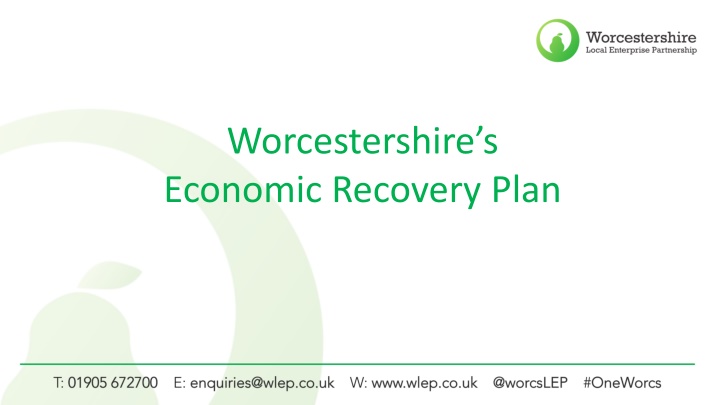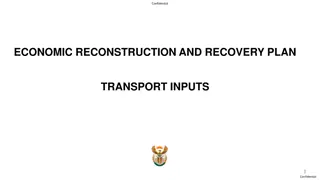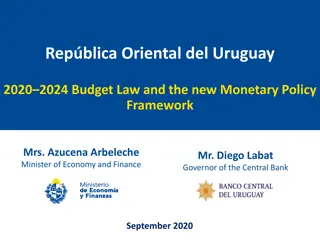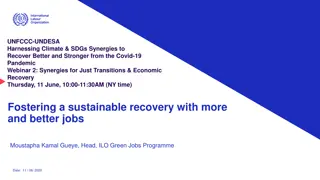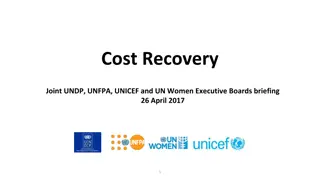Worcestershire Economic Recovery Plan
The Worcestershire Economic Recovery Plan aims to address the economic impact of the coronavirus pandemic, with insights on national business impact, GDP, unemployment projections, and local implications for various districts. The plan includes strategies to support businesses and workforce resilience during these challenging times.
Download Presentation

Please find below an Image/Link to download the presentation.
The content on the website is provided AS IS for your information and personal use only. It may not be sold, licensed, or shared on other websites without obtaining consent from the author.If you encounter any issues during the download, it is possible that the publisher has removed the file from their server.
You are allowed to download the files provided on this website for personal or commercial use, subject to the condition that they are used lawfully. All files are the property of their respective owners.
The content on the website is provided AS IS for your information and personal use only. It may not be sold, licensed, or shared on other websites without obtaining consent from the author.
E N D
Presentation Transcript
Worcestershires Economic Recovery Plan
National Business Impact - Business Impact of Coronavirus Survey, ONS: 24% of businesses reported they had temporarily closed or paused trading for the period 23 March to 5 April 2020, while 75% were continuing trading. The two sectors that reported the largest percentages of businesses temporarily closing or pausing trading were the arts, entertainment and recreation sector and the accommodation and food services sector, reporting 82% and 81% respectively. 27% of the workforce had been furloughed, 14% of the workforce in businesses that continued trading and 78% of the workforce in businesses that had temporarily closed or had paused trading. The highest proportion of workforce being furloughed was in the accommodation and food service activities industry (80%) and in the art, entertainment and recreation industry (68%). 40% of businesses continuing to trade reported having to reduce staff numbers in the short-term. Businesses within the construction industry had one of the highest proportions of reducing staffing levels in the short term, at 64%. For businesses continuing to trade, 60% were confident they would have the financial resources to continue operating throughout the COVID-19 pandemic; only 6% did not feel confident they had the resources available.
GDP & Unemployment - Office for Budget Responsibility coronavirus reference scenario Estimates the share of output that would be lost in each industry in the second quarter of 2020 assuming a three- month lockdown due to public health restrictions. The impact is assumed to halve in the third quarter as restrictions are eased, and activity returns to pre-outbreak levels in the fourth quarter. Real GDP falls 35% in the second quarter, with a 13% fall in annual GDP in 2020 Unemployment rises to 10 per cent in the second quarter but then declines more slowly than GDP recovers. Around a quarter of the rise in unemployment reverses in each of the next two quarters, with more gradual reductions after this
Local Picture - Economic impact of coronavirus by local authority - Centre for Progressive Policy Analysis Applies the OBR methodology to all 382 UK local authorities to reflect their share of GVA in each sector. The reduction in GVA in the second quarter ranges from 49% to 18%. Results for Worcestershire districts are shown in the table below, with impacts for Bromsgrove and Worcester estimated to be below the UK average of 35%. Results for available comparator areas suggest similar impacts to Worcestershire.
Local Picture - Economic impact of coronavirus by local authority - Centre for Progressive Policy Analysis Other Comparator Areas Area Local Authority Decline in GVA Rank Stroud Forest of Dean Tewkesbury Cheltenham Cotswold 44% 43% 41% 35% 32% 19 39 77 248 322 Gloucestershire Gloucester Stratford-on-Avon North Warwickshire Rugby Nuneaton and Bedworth Warwick Birmingham Dudley Walsall Sandwell Wolverhampton 31% 46% 45% 45% 36% 34% 35% 39% 38% 36% 32% 347 4 11 12 244 281 254 154 176 224 329 Warwickshire Birmingham Black Country
Impact on unemployment levels: Latest claimant count data relates to claims that were live on 12 March and will not reflect increases in claims as a result of coronavirus social distancing measures. In the 6 weeks to 12 April 2020, declarations to Universal Credit in Great Britain were almost 5 times higher than the amount of declarations received from individuals in the same period last year, equivalent to 50% of the number of individuals on Universal Credit at 12 March 2020. However, the caseload will not necessarily increase by 50% as some of these declarations will not go on to start receiving Universal Credit. (Note the claimant count measure of unemployment differs from the wider measure of unemployment which also includes those actively seeking work and not claiming benefits). We expect the next claimant count data to be released 19th May 2020
Worcestershire business survey (239 online responses) 70% of businesses responding cited lack of cash flow as a key way in which the business has been affected 50% of businesses have been affected by temporary cessation Other key impacts - access to customers in the UK (129 businesses) Over a quarter of respondents have been affected by business closure The telephone survey also identified that 56% of respondents have furloughed employees
Worcestershire business survey (239 online responses) Lack of income is the top concern for businesses at present and in the future (90% of respondents) 55% of respondents said that possible cessation of trading is a future concern Staff retention and reducing productivity are also becoming key concern for the future (around 40% of respondents)
Our largest private sector employers Our largest 150 employers account for approximately 50% of all private sector jobs What are they telling us: Many of them have taken up the opportunity of the Job Retention Scheme and furloughed staff the percentage of staff furloughed varied greatly from 0% to almost 100% Conversations over the past week have started to focus on reopening and bring people back to the work place e.g. JLR supply chain due back 18th May , though at the moment this is anticipated to be approx. 30% of staff and operating staggered start times Considerations for return to work have included PPE, the ability to apply social distancing in the workplace, supply chains and also routes to market open e.g. in the case of manufacture for retail environments. Concerns about the flexibility of the furlough scheme in terms of workforce being allowed to come into work to fulfil order, but may need to then go back on furlough, the time it will take to regain cashflow after a period of low sales figures. A number of the companies have reported that they may look to adopt changes to working practices noting productivity of homeworking, the benefit of video conferencing etc.
Considerations for Recovery and Resilience Business Issues o Business change and transformation projects to accommodate new working practices o Business continuity o Introduction of new technology o Product/service diversification o Opportunity to scale up production o Diversification into new markets o Supply Chain Skills and Training o Training for employees in a changing environment o Training for the unemployment and getting back into work o Basic skills improvement English/Maths/Digital o Not in Employment, Education and Training (NEETs)
Considerations for Recovery and Resilience Impact on Public Transport e.g. perceived / real risk in use, capacity o Rail o Bus o Rural movement Commercial Property market e.g. impact of technology / home working on office occupational market Future of the High Street/retail Tourism and Leisure Sector
Key Organisations Involved Business Representative Organisations e.g. Chamber, CBI, FSB, NFU Represent member views, lobbying HMG, reach across target sectors, part of wider national structures District Councils (x6) Distribution channel for HMG funding and business rates rebate, local community liaison, place management and knowledge of high street and town centres, increasing tourism offer Midlands Engine (incl. Economic Observatory) Providing regional overview of impact on Midlands economy, and sharing best practice across the region Worcestershire Business Central Front door for Worcestershire businesses, acting as one-stop shop and primary online portal for sharing up-to-date information on latest central government support, gleaning local business intelligence via surveys and reporting regularly to BEIS Worcestershire County Council Management and delivery of growth and enterprise intervention programmes, economic policy and research, coordination of Visit Worcestershire, transport authority and influence over health and social care market
Key Organisations Involved Worcestershire LEP Economic strategy and research, strategic leadership and relationship with businesses in the county, coordinating local, regional and national activity, leading on DWP and labour market relationships, business-led voice back into HMG, collaborating with WM LEPs and national LEP Network Worcestershire Regulatory Services Maintaining regulatory duty role across the county, providing support and advice Greater Birmingham & Solihull LEP Similar role as WLEP but on GBS geography, providing potential opportunities for North Worcestershire- based businesses as local GBSLEP schemes / initiatives launched West Midlands Combined Authority Potential for Interventions across 3 LEP Geography
Our response so far 1 LA partners working to administer government financial support District Councils were allocated 134.5m under the Business support grants programme and have paid out over 91m (68% of the total budget), the total number of businesses eligible for the grant in the county is 10,701 with the number of payments made being 7,751 (72%) (latest as at 26 April). Additional 617m announced by government to fill the gaps of the Business Support Grants and also financial support for BIDS. 2 Coordination with Local Government, Public Sector Agencies and LEPs Engaged in the coordination of public sector agencies across Worcestershire to ensure consistent messaging and approach to COVID response This response group will also ensure a joined-up approach as we start to consider medium to longer-term economic recovery measures WLEP working as West Midlands LEP to share ideas and feedback into Govt through the LEP Network 3 Engaging with Midlands Engine to understand regional impact Contributing to emerging ME proposals to upscale the Midlands Observatory which will see LEP geographies sharing local insights and intelligence into ME will coordinate and provide a regional picture which can be used for communication with central government and inform economic recovery strategy
Our response so far 4 Regular dialogue with banks and finance brokers Looking to establish a local Economic Recovery Forum with input from local finance, banking and professional services representatives to act as mouthpiece in coordinating advice to Worcestershire businesses and to tackle FAQs. 5 Launched online business content and delivery - podcast series/webinars/virtual New platform for engaging existing and new networks. Making Connections is a selection of podcasts/webinars, which have begun to publish resources and information for businesses about COVID-19 WLEP, WCC, District Councils, HW Chamber, FSB, are all providing online content and support- WBC has seen a significant increase in business engagement of between 25-40% against this time last year WBC has seen website hits increase from 6500 to almost 11,000 6 Lobbying Government for greater resources / flexibility HW Chamber and FSB continue to lobby government on behalf of members to ensure businesses do not go unsupported Partners come together in weekly reporting to BEIS led by WBC Contributed to development of a LEP Network paper into Govt seeking greater funding flexibilities
Our response so far 7. Worcestershire Skills Information and Guidance Service launched Targeted at 16-24-year olds with particular focus on those who were due to take their GCSE and A-level examinations this year 8 Worcestershire Jobs Match Service launched Launched 16 April, supporting the following issues a) businesses looking to make redundancies; b) businesses requiring labour; c) businesses keen to redeploy staff; d) individuals seeking employment 9 Provision of clear and consistent Business Support Dedicated online portal signposting to Government packages of support provided by WLEP and GBSLEP growth hubs Proactively contacting businesses / gathering business intelligence via surveys Webinars to provide practical support / coordinated across partners Reshaping of existing support programmes across Worcestershire and GBS LEP area
WLEP Strategic Programme Framework (pre-COVID) Worcestershire 2040: WLEP Vision A Connected, Creative, Dynamic Economy for All BUSINESS ENVIRONMENT (SUPPORT) Five IDEAS PEOPLE (SKILLS) PLACES INFRASTRUCTURE Foundations of Productivity (INNOVATIONS) (COMMUNITIES) Improving our Connectivity (Physical infrastructure, Digital Infrastructure, and Energy Infrastructure renewable generation / low carbon) Shaping our Future Skills and Workforce (Addressing Ageing Demography, Talent Attraction and Retention) Our Strategic Objectives (supported by LIS Evidence Base) Revitalising our City and Town Centres (including Game Changer 2 employment sites programme) Increasing Research & Development and Innovation (Attracting and sustaining high value jobs)
WLEP Strategic Programme Framework (pre-COVID) Worcestershire 2040: WLEP Vision A Connected, Creative, Dynamic Economy for All A38 Improvements Redditch Town Centre Regeneration & Rail Investment A46 Improvements Trans Midland Trade Corridor Worcester Shrub Hill Regeneration & Rail Investment Our Big Ideas Gigabit-capable digital infrastructure county -wide Work Placements programme across Schools, FE & HE (Priority Projects) North Cotswold Rail Line Improvements Health & Well-Being Campus @ UoW North Worcestershire Game Changer (incl. 5G testbed) Sustainable Energy Zones Technology-focused European-scale Science Park @ Malvern Investment in Agri-Tech (post-Brexit)
WLEP Strategic Programme Framework (pre-COVID) Worcestershire 2040: WLEP Vision A Connected, Creative, Dynamic Economy for All Future Skills and Workforce Planning (employer-led) Digital Infrastructure and Connectivity (Build / Deployment) Sustainable Employment Land / Premises Innovation Programme (including BetaDen) City and Town Centre Investment Plan Digital Business Transformation / 5G Adoption Strengthening Schools and Business Engagement Highways Investment Programme Inward Investment Housing Our Business Support Programmes (including Access to Finance) Increasing Employability Rail Investment Programme Heritage and Culture Proposed Programmes Influencing Future Curriculum (provider-led) Environmental Infrastructure Investment Programme Business Scale-Up / Growth Programmes Skills Capital Investments Programme Energy Strategy Business & Professional Services Advanced Manufacturing Cyber, IT and Defence Our Target Sectors Construction Health & Care Agri-Tech Key Growth Sectors Key Cornerstone Sectors
Questions: In light of the fact that all government messaging is the Local Industrial Strategy will be refocused into a Local Economic Recovery plan : What should a Recovery Plan look like/address? In light of the fact that large national schemes such as the Job retention Scheme or Business Loans schemes are in place Are we pursuing the recovery of GVA or employment i.e. is it about economic wellbeing of all stakeholders in the economy bearing in mind that our vested interest in the reduction/avoidance of increases costs related to demands on our services? How does this affect the long term vision and should we maintain our project list or change it in light of the economic recovery? Where is our greatest opportunity for Impact/Influence? With limited resources What should the LEP do and what is its role? What shouldn t we do i.e. what would be wasted effort?
